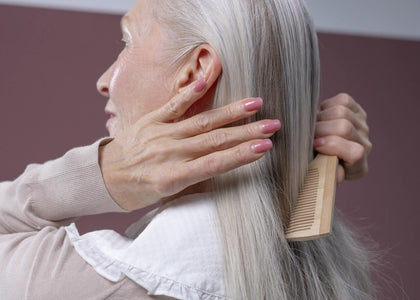You aren't alone if you find yourself wondering, "Why does my hair get tangled so easily?" Tangled hair strands are a common issue. However, certain factors can make your hair tangle more easily than normal.
Here are some reasons why your hair might get tangled so easily and how to cut down on the snarls — plus, find out what hair care products can help you build the perfect hair wellness routine.
Why Hair Tangles
So why does hair tangle? VEGAMOUR spoke to hair and beauty expert Gwenda Harmon to get the inside scoop and learn about the factors that might be increasing your hair's tangle factor.
"Hair is made up of individual strands of keratin, a protein that also forms the nails and outer layers of skin," Harmon explained. "These strands are held together by fragile bonds called disulfide bridges. When these bonds are broken, the hair becomes more vulnerable to tangling. Once the bonds are broken, the individual strands of hair can become tangled around each other, leading to knots and tangles. "
Hair is particularly prone to tangles when wet. "When your hair is wet, it's more susceptible to tangles and knots," said Harmon. "This is because the cuticle, or outer layer of your hair, is raised when it's wet. This makes it easier for individual strands to become entangled with each other."
A little hair tangling is normal. However, if your hair is especially tangled, these factors might be to blame:
1. Environmental Damage
Living in a harsh environment can cause strands to tangle. "Damage from environmental factors like humidity, wind and sun can cause hair breakage," said Harmon. If you live in a place where the weather stresses out your strands, your hair will likely be more tangle prone.
Shop: VEGAMOUR Best Sellers
2. Harsh Hair Care Routine
According to Harmon, heat styling, chemicals and other harsh hair products can make your hair shaft more prone to breakage. Don't blow dry or use hot tools too often if you want to avoid tangles. Additionally, always use a heat protectant spray.
3. A Tangle-Prone Hair Type
Some hair types and textures are inherently more prone to tangles. Fine hair, long hair, textured hair and thick hair — where hair knots can lurk undetected — are especially likely to tangle. If you have tangle-prone hair, it's worth taking steps to give hair a little extra slip with daily conditioner, deep conditioner or hydrating leave-in conditioner to prevent the snarls.
4. Wet Styling
"Wet hair is weaker and more fragile than dry hair, so it's more likely to break if you try to brush out a knot," said Harmon. "Avoid brushing your hair when it's wet, as this can further damage delicate strands."
5. Damaged Hair
If your hair cuticles are damaged, they're more likely to snag. Split ends and dry cuticles depleted of their natural oils can cause increased tangling and lead to breakage. Frequent trims can help prevent tangling.
6. Incorrect Brushing Techniques
Brushing should protect your hair, but if done incorrectly, it can cause damage. Harmon recommends you detangle hair before getting it wet. "Comb your hair with a wide-toothed comb before washing it," she suggested. "If your damp hair still has tangles, separate it into manageable sections and use a wide-toothed comb to remove any tangles by starting at the bottom part of your hair. Be sure to use a gentle touch, as pulling too hard can cause breakage."
See: Comb vs. Brush — When and How to Use Each
7. Incorrect Wash Day Frequency
Making sure to wash your hair with the right frequency is also key for avoiding tangles. If you wash too little, your dirty hair will be more prone to snags. But too frequent washing can leave strands drained of moisture. Experiment to find the right schedule for your strands.
8. Bad Wash Day Habits
The products you use on wash day impact your hair health all week long, and that includes hair tangling! Harmon advises sticking to gentle shampoos and using a conditioner that fits your hair's needs. "Don’t shampoo the ends to avoid stripping them of moisture," she said, "and be generous when applying conditioner, especially if you have longer hair."
Related: Get to Know VEGAMOUR's Shampoos & Conditioners
9. Harsh Hair Handling
How you wash your hair is as important as the products you use. "Don’t swirl your hair in different directions when shampooing," advised Harmon. "Instead, do a massaging motion on your scalp from the top of the head to the neck area."
10. Not Enough Moisture
Last but not least, dry hair can result in tangles. Using deep-conditioning hair masks or applying natural moisturizers, like coconut oil or marula oil, is the best way to make sure your strands stay hydrated and free of tangles.
Prevent Tangles With a Knot-Busting Routine
If you struggle with tangles, Harmon said that adopting a knot-protectant routine can help keep hair strands tangle-free. "A good hair care routine is essential for preventing tangles," she said.
To keep your hair free of tangles, start by clearing strands of any existing snags and snarls. "The first step is to gently brush your hair with a soft, wide-tooth comb," said Harmon. (If you have particularly thick hair, a paddle brush will also work.) "Start at the bottom and work your way up, taking care not to tug or pull on strands."
Once your hair is tangle free, it's time for wash day. "Once your hair is free of knots, you can shampoo and condition it as usual," said Harmon. "Be sure to use products that are designed for your specific hair type."
Once your hair is washed, it's time for gentle drying. "After rinsing, squeeze excess water from your hair and wrap it in a microfiber towel," said Harmon.
A T-shirt also will work to absorb moisture and is especially good protection if you're deep conditioning or "plopping" to encourage the formation of curls.
"Gently pat your hair dry, then comb through it again to remove any remaining tangles," Harmon said. Again, make sure not to pull too hard, as drying hair is still more prone to breakage.
Harmon recommended that you stay away from all heat tools and styling if your hair is especially tangle-prone. "Let your hair air dry whenever possible, as heat styling can damage delicate strands," she said. Reserve the heat for special occasions whenever possible.
Last but not least, Harmon says that moisturizing between washes can help keep tangles at bay until your next wash day. "Use a leave-in conditioner or detangling spray to help keep your hair manageable throughout the day," she said.
Some people also sleep on a silk pillowcase, which they find cuts down on snarls as they sleep, or apply a protective hairstyle, such as braids.
Less Tangled Hair for a Happier You
The less time you spend worrying about tangles, the more you can focus on overall hair health!
Start by using a gentle shampoo and conditioner designed to support hair health from the inside out. Next, take care of your hair by only using a comb to detangle hair when wet. You can also do other things like using a leave-in conditioner and sleeping on a silk pillowcase. By using these tips, you should be able to keep the snags at bay and look forward to better hair days on the horizon!
#include-related-slider#
More From VEGAMOUR
- Why Does the Bottom Layer of My Hair Get So Tangled?
- How to Keep Your Hair From Getting Matted While Sleeping
- How to Detangle Hair With Minimal Damage
Photo credit: Cottonbro Studio/Pexels




















